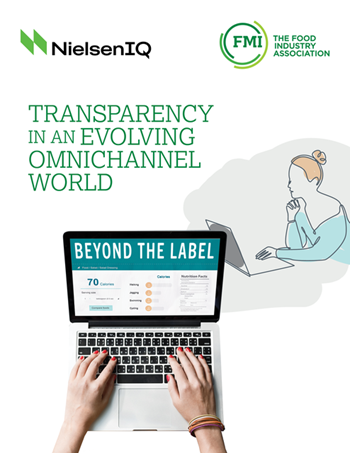<div>
<p paraid="42229459" paraeid="{524d92f5-d5e3-43c8-b3ac-8a57a15a11a7}{215}">Allison Febrey, Manager, Research & Insights </p>
</div>
<div>
<p paraid="1654223482" paraeid="{524d92f5-d5e3-43c8-b3ac-8a57a15a11a7}{221}"><img src="https://www.fmi.org/images/default-source/research-resources/6c60d80000029a-cover-transparency_hwb_report_cover.tmb-large-350-.png?sfvrsn=89146fd_1" data-displaymode="Thumbnail" alt="Transparency" title="Transparency" style="float: right; margin: 10px;" />Growing up, we’re always told that honesty is the best policy. This is true not only in social settings, but also for food. In the midst of our rapidly evolving world, some basic principles still apply, and transparency continues to be a focus for consumers. According to the newly-released <a href="https://www.fmi.org/forms/store/ProductFormPublic/transparency-evolving-omnichannel-world" target="_blank" rel="noreferrer noopener">Transparency in an Evolving Omnichannel World</a> report from FMI and NielsenIQ, about three quarters of shoppers surveyed agree seeing transparency from brands and manufacturers is important or extremely important. Transparency was defined as providing detailed information such as what is in food and how it is made, which is key to building trust and loyalty and shoppers now expect it. </p>
</div>
<div>
<p paraid="1348564196" paraeid="{cd959596-57e0-4fc1-9178-31ecd900d5ba}{69}">Shoppers consider a range of stakeholders, from manufacturer brands to grocery stores, as responsible for providing transparency. However, the high levels of responsibility don’t equate to similarly high levels of shopper trust. A case in point is with manufacturers and brands: Shoppers are most likely to cite manufacturers or brands as being either completely (57%) or partially (37%) responsible for providing detailed product information. However, only 31% of shoppers completely trust the information provided by manufacturers or brands. </p>
</div>
<div>
<p paraid="82835470" paraeid="{cd959596-57e0-4fc1-9178-31ecd900d5ba}{105}">This presents an opportunity to earn consumer trust and loyalty through greater transparency. Shoppers say transparency boosts their trust in manufacturers and retailers. For example, one shopper expressed skepticism about nutritional information. “I’m careful because you have to examine what is being said,” said this shopper. “Some are buzzwords, and some are true nutritional facts. So, which is it? It’s hard to decipher until you look really closely at the ingredients.” </p>
</div>
<div>
<p paraid="1935842614" paraeid="{cd959596-57e0-4fc1-9178-31ecd900d5ba}{139}">Going beyond the label is one strategy to boost trust. Almost two-thirds of shoppers (64%) say they would switch from a brand they usually buy to another brand that provides more in-depth product information, beyond what is provided on the physical label. Fortunately, there are free tools on the market, like SmartLabel®, that help consumers bridge the informational gap when certain details are left off a product’s packaging. Learn more about this convenient, easy-to-use tool here: <a href="http://smartlabel.org/" target="_blank" rel="noreferrer noopener">http://smartlabel.org/</a> </p>
</div>
<div>
<p paraid="332619917" paraeid="{cd959596-57e0-4fc1-9178-31ecd900d5ba}{155}">For more information on building trust through transparency, tune into a live conversation with FMI and NielsenIQ on February 24, 2022, to dive deep into the demand for transparency, the omnichannel playing field, and the opportunity to win consumer loyalty. <a href="https://nielseniq.com/global/en/insights/multimedia/2022/webinar-table-stakes-the-practical-implication-of-transparency-in-omnichannel-retail/" target="_blank" rel="noreferrer noopener">Register here.</a> </p>
</div>
<div>
<p paraid="42229459" paraeid="{524d92f5-d5e3-43c8-b3ac-8a57a15a11a7}{215}">Allison Febrey, Manager, Research & Insights </p>
</div>
<div>
<p paraid="1654223482" paraeid="{524d92f5-d5e3-43c8-b3ac-8a57a15a11a7}{221}"><img src="https://www.fmi.org/images/default-source/research-resources/6c60d80000029a-cover-transparency_hwb_report_cover.tmb-large-350-.png?sfvrsn=89146fd_1" data-displaymode="Thumbnail" alt="Transparency" title="Transparency" style="float: right; margin: 10px;" />Growing up, we’re always told that honesty is the best policy. This is true not only in social settings, but also for food. In the midst of our rapidly evolving world, some basic principles still apply, and transparency continues to be a focus for consumers. According to the newly-released <a href="https://www.fmi.org/forms/store/ProductFormPublic/transparency-evolving-omnichannel-world" target="_blank" rel="noreferrer noopener">Transparency in an Evolving Omnichannel World</a> report from FMI and NielsenIQ, about three quarters of shoppers surveyed agree seeing transparency from brands and manufacturers is important or extremely important. Transparency was defined as providing detailed information such as what is in food and how it is made, which is key to building trust and loyalty and shoppers now expect it. </p>
</div>
<div>
<p paraid="1348564196" paraeid="{cd959596-57e0-4fc1-9178-31ecd900d5ba}{69}">Shoppers consider a range of stakeholders, from manufacturer brands to grocery stores, as responsible for providing transparency. However, the high levels of responsibility don’t equate to similarly high levels of shopper trust. A case in point is with manufacturers and brands: Shoppers are most likely to cite manufacturers or brands as being either completely (57%) or partially (37%) responsible for providing detailed product information. However, only 31% of shoppers completely trust the information provided by manufacturers or brands. </p>
</div>
<div>
<p paraid="82835470" paraeid="{cd959596-57e0-4fc1-9178-31ecd900d5ba}{105}">This presents an opportunity to earn consumer trust and loyalty through greater transparency. Shoppers say transparency boosts their trust in manufacturers and retailers. For example, one shopper expressed skepticism about nutritional information. “I’m careful because you have to examine what is being said,” said this shopper. “Some are buzzwords, and some are true nutritional facts. So, which is it? It’s hard to decipher until you look really closely at the ingredients.” </p>
</div>
<div>
<p paraid="1935842614" paraeid="{cd959596-57e0-4fc1-9178-31ecd900d5ba}{139}">Going beyond the label is one strategy to boost trust. Almost two-thirds of shoppers (64%) say they would switch from a brand they usually buy to another brand that provides more in-depth product information, beyond what is provided on the physical label. Fortunately, there are free tools on the market, like SmartLabel®, that help consumers bridge the informational gap when certain details are left off a product’s packaging. Learn more about this convenient, easy-to-use tool here: <a href="http://smartlabel.org/" target="_blank" rel="noreferrer noopener">http://smartlabel.org/</a> </p>
</div>
<div>
<p paraid="332619917" paraeid="{cd959596-57e0-4fc1-9178-31ecd900d5ba}{155}">For more information on building trust through transparency, tune into a live conversation with FMI and NielsenIQ on February 24, 2022, to dive deep into the demand for transparency, the omnichannel playing field, and the opportunity to win consumer loyalty. <a href="https://nielseniq.com/global/en/insights/multimedia/2022/webinar-table-stakes-the-practical-implication-of-transparency-in-omnichannel-retail/" target="_blank" rel="noreferrer noopener">Register here.</a> </p>
</div>





